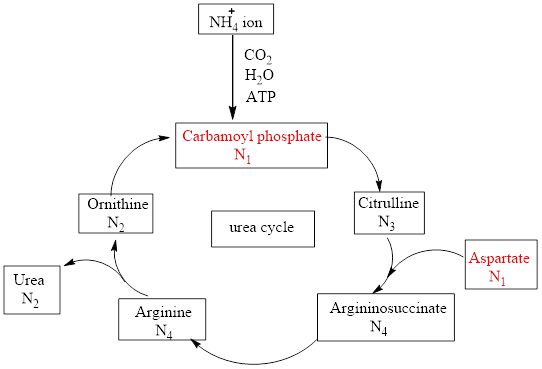
Concept explainers
(a)
Interpretation: To characterize ornithine in terms of nitrogen content
Concept introduction: Urea cycle is a cyclic biochemical pathway that involves the production of urea using ammonium ions and aspartate molecules as nitrogen sources. It converts toxic ammonium ion to urea which is then excreted from the body in urine. Urea cycle can be explained in terms of the nitrogen content of all the compounds participating in the urea cycle as follows:

(b)
Interpretation: To characterize citrulline in terms of nitrogen content
Concept introduction: Urea cycle is a cyclic biochemical pathway that involves the production of urea using ammonium ions and aspartate molecules as nitrogen sources. It converts toxic ammonium ion to urea which is then excreted from the body in urine.
Urea cycle can be explained in terms of the nitrogen content of all the compounds participating in the urea cycle as follows:

(c)
Interpretation: To characterize aspartate in terms of nitrogen content
Concept introduction: Urea cycle is a cyclic biochemical pathway that involves the production of urea using ammonium ions and aspartate molecules as nitrogen sources. It converts toxic ammonium ion to urea which is then excreted from the body in urine. Urea cycle can be explained in terms of the nitrogen content of all the compounds participating in the urea cycle as follows:

(d)
Interpretation: To characterize argininosuccinate in terms of nitrogen content
Concept introduction: Urea cycle is a cyclic biochemical pathway that involves the production of urea using ammonium ions and aspartate molecules as nitrogen sources. It converts toxic ammonium ion to urea which is then excreted from the body in urine. Urea cycle can be explained in terms of the nitrogen content of all the compounds participating in the urea cycle as follows:

Want to see the full answer?
Check out a sample textbook solution
Chapter 26 Solutions
General, Organic, and Biological Chemistry
- The committed step in the urea cycle is: A、condensation of citrulline with aspartate B、export of citrulline from the matrix C、cleavage of urea from arginine D、Formation of carbamoyl phosphatearrow_forwardDiscuss the two roles of N-acetylglutamate in the urea cycle. Include relevant chemical structures and reactions. What is the regulatory function of N-acetylglutamate in the urea cycle? What is the other role of N-acetylglutamate in relationship to the urea cycle? Glutamate is the precursor for N-acetylglutamate. How is glutamate involved in the connection between the urea cycle and the CAC?arrow_forwardThe urea cycle requires all of the following components except one of them: aspartate, carbamoyl phosphate synthetase I, ATP, citrulline/ornithine transporter and isocitrate. Identify the component. Explain the sequence of urea cycle using the required components and enzymes essential for each step of the cycle.arrow_forward
- Which of the following is a substrate in the urea cycle? a. fumarate b. glutamate c. aspartate d. α-ketoglutaratearrow_forwardThe reaction of glutamate and NH4* to yield glutamine is catalyzed by. a) Uridylyltransferase b) Adenylyltransferase c) Glutamate synthase d) Glutamine synthasearrow_forwardCarbamoyl-phosphate synthase I is a mitochondrial enzyme which plays an important role in the urea cycle. It represents the committed step in the urea cycle. (i) Explain the reaction of carbamoyl-phosphate synthase I. (ii) Explain the regulation of urea cycle by N-acetylglutamate.arrow_forward
- From the three figures below, indicate which represents best the catalytic pocket of trypsin, a serine protease, secreted by acinar pancreatic cells. C) A) A. Figure A. B.Figure B. ⒸC. Figure C. Asp 189 B) Asp 189 Val 190 Val 216 work of Val 216 Val 190arrow_forwardWhich of the following statements regarding the urea cycle is true? (A) Fumarate acts as a connecting link between urea cycle and the CAC.(B) The urea cycle occurs solely in the mitochondria.(C) Citrulline and arginine reacts to form argininosuccinate.(D) Ornithine formed in the last reaction of the urea cycle is excreted from the body along with urea.(E) The purpose of the urea cycle is to produce energy (4 ATP per ammonia that enters) for the liver.arrow_forwardDefine the following terms: a. lactone b. aldaric acid c. aldonic acid d. uronic acid e. epimerizationarrow_forward
- If aspartate is labeled with deuterium D (= H-2 = 12H), answer questions a-c to determine where the label will end up in oxaloacetate after the involvement of aspartate in the urea cycle. Where does the label end up in arginosuccinate? Where is the label in fumarate? Where is the label in oxaloacetate?arrow_forwardHomocystinuria is caused by a defect in cystathionine beta-synthase (or 13-synthase), which leads to an accumulation of homocysteine in the blood. This accumulation causes symptoms such as a tall, thin frame, flushed cheeks, and osteoporosis (thinning of the bones). These individuals should limit their intake of proteins that contain methionine, such as egg whites. Using your understanding of biochemistry, explain why people with Homocystinuria should not consume egg whites and other such proteins.arrow_forwarda) What is the role of the lysosome in degrading proteins? What are the enzymes that degrade/hydrolyze proteins? How does the further degradation of amino acids occur?b) Explain the urea cycle and summarize the steps of the urea cycle starting from carbamoyl phosphate.arrow_forward
 Human Anatomy & Physiology (11th Edition)BiologyISBN:9780134580999Author:Elaine N. Marieb, Katja N. HoehnPublisher:PEARSON
Human Anatomy & Physiology (11th Edition)BiologyISBN:9780134580999Author:Elaine N. Marieb, Katja N. HoehnPublisher:PEARSON Biology 2eBiologyISBN:9781947172517Author:Matthew Douglas, Jung Choi, Mary Ann ClarkPublisher:OpenStax
Biology 2eBiologyISBN:9781947172517Author:Matthew Douglas, Jung Choi, Mary Ann ClarkPublisher:OpenStax Anatomy & PhysiologyBiologyISBN:9781259398629Author:McKinley, Michael P., O'loughlin, Valerie Dean, Bidle, Theresa StouterPublisher:Mcgraw Hill Education,
Anatomy & PhysiologyBiologyISBN:9781259398629Author:McKinley, Michael P., O'loughlin, Valerie Dean, Bidle, Theresa StouterPublisher:Mcgraw Hill Education, Molecular Biology of the Cell (Sixth Edition)BiologyISBN:9780815344322Author:Bruce Alberts, Alexander D. Johnson, Julian Lewis, David Morgan, Martin Raff, Keith Roberts, Peter WalterPublisher:W. W. Norton & Company
Molecular Biology of the Cell (Sixth Edition)BiologyISBN:9780815344322Author:Bruce Alberts, Alexander D. Johnson, Julian Lewis, David Morgan, Martin Raff, Keith Roberts, Peter WalterPublisher:W. W. Norton & Company Laboratory Manual For Human Anatomy & PhysiologyBiologyISBN:9781260159363Author:Martin, Terry R., Prentice-craver, CynthiaPublisher:McGraw-Hill Publishing Co.
Laboratory Manual For Human Anatomy & PhysiologyBiologyISBN:9781260159363Author:Martin, Terry R., Prentice-craver, CynthiaPublisher:McGraw-Hill Publishing Co. Inquiry Into Life (16th Edition)BiologyISBN:9781260231700Author:Sylvia S. Mader, Michael WindelspechtPublisher:McGraw Hill Education
Inquiry Into Life (16th Edition)BiologyISBN:9781260231700Author:Sylvia S. Mader, Michael WindelspechtPublisher:McGraw Hill Education





